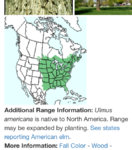Dan92119
Mame
I haven’t noticed this before because until recently I had only had Chinese elms. This year I grew from seed American elms. I have three elms in a grow bed all within 12 in of each other, one Chinese elm and two American elms. The American elms get chewed up by bugs, grasshopper and some type of green worm. Nothing touches my Chinese elms. The spiders will use the Chinese elms for their webs.
Has anyone else noticed this? Just curious.
Thanks!
Has anyone else noticed this? Just curious.
Thanks!

